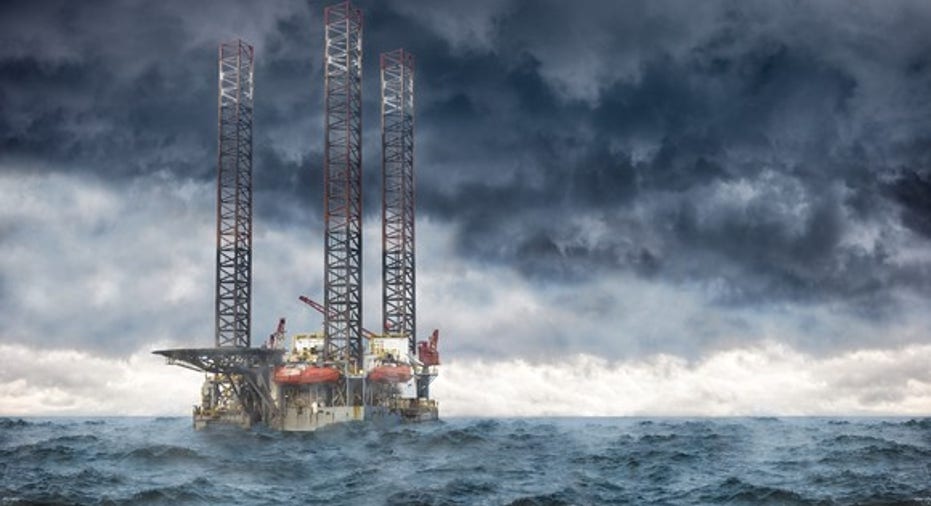Seadrill Ltd. Just Got Even Riskier

Seadrill must continue navigating the worst offshore drilling environment in decades. Image source: Getty Images.
So much for a drilling recovery just yet.
On Monday , offshore drillerSeadrill Ltd. (NYSE: SDRL) announced that it had received notice from Pemex that it was canceling itscontract for the West Pegasus semi-submersible drilling vessel, yet another reminder that the offshore drilling environment remains in a serious downturn.
But here's what makes this particular cancellation unusual: Pemex and Seadrill had just signed the contract in the first quarter of 2016.
Overall, it's a troubling reminder how far we may be from a recovery. And that's particularly bad news for Seadrill, which has a lot of debt coming due and newbuilds on track to be delivered in the near term.
Let's take a closer look at what just happened, and what it means for Seadrill.
What just happened
This actually goes back to the second quarter of 2015, when Seadrill and Pemex signed a "provisional commitment" for a two-year extension of theWest Pegasuscontract. The extension, for whichSeadrill would charge a day rate based on the average day rates of a basket of similar drilling vessels, had a potential revenue of approximately $266 million for the company.
But this is where the water gets a little muddy.
West Pegasus. Image source: Seadrill.
According to the terms of the agreement, Seadrill and Seamex -- the 50/50 joint venture which owns the vessels (Seadrill is the operator) -- agreed to reduce the day rates for 365 days on five other vessels under contract with Pemex by $20 million. Furthermore, the contract also reduced the prior backlog on the West Pegasusby $45 million.
In other words, Seadrill may have just gotten stiffed, since it has been discounting the day rates on the other five vessels since earlier this year. The company said in the release that it was entitled to recover the day rate concessions it agreed to, as well as demobilization costs for theWest Pegasus, but these amounts were not disclosed in the release.
Things may continue to get worse, too
Over the past year, Seadrill (along with every other offshore driller) has dealt with an almost total collapse in capital spending for new exploration and drilling offshore. Perhaps the clearest sign of how bad things are came in May, when Norway-based Statoil ASA paid Seadrill $61 millionto cancel a drilling contract. In short, Statoil decided to pay $61 million to delay a project rather than invest in new production.
And with crude prices staying near $50 a barrel, it's unlikely that offshore development is going to recover any time soon. There remains a glut of oil and refined products in storage, global demand growth is stagnant at best, and onshore production can be ramped up quickly and more cheaply than offshore.
What it means for Seadrill
The big concern about Pemex's move is that it could be an indication that even short-term, market-priced work will be hard to find. Seadrill's edge is the technical capability of many of its high-spec vessels, which are younger, more capable, and better-operated than theolder rigs of many of its competitors. In a high-demand market, these vessels are typically able to command long-term contracts at above-market rates, and even in a weak demand environment such as the current one, they are more likely to find work at closer to market rates on short-term deals.
Unfortunately, the downturn seems to have become so severe that even a market-rate deal may be more than Seadrill can count on for its newer, high-spec vessels. TheWest Pegasuscertainly qualifies. The vessel, built in 2011, is capable of operating in 10,000 feet of water, and drilling to depths of 35,000 feet.
Doing all it can
Uncertainty equals risk, and that's certainly the case for offshore drillers, considering how little indication there is that offshore spending has even bottomed out. Seadrill is particularly exposed, with $3.2 billion in liabilities due over the next year, including debt coming due and newbuild vessels scheduled for delivery.
The company has made some progress, regularly getting shipbuilders to agree to push back delivery dates, and also reached an agreement with its banking partners to push its near-term credit facility maturations back. But an investing thesis shouldn't count on the willingness of bankers to keep rolling loans over, nor in shipbuilders to keep sitting on vessels that are ready for delivery.
Seadrill is set to announce second-quarter earnings on Thursday, so we should get an update on both newbuild and debt negotiations. There could be more good news -- at least in the form of further delays. But as things stand now, Seadrill's debt and newbuild liabilities create significant risk, and the only thing that's going to reduce that risk is a recovery in offshore drilling.
But this latest contract cancellation is a reminder that a recovery offshore isn't anywhere close to starting.
A secret billion-dollar stock opportunity The world's biggest tech company forgot to show you something, but a few Wall Street analysts and the Fool didn't miss a beat: There's a small company that's powering their brand-new gadgets and the coming revolution in technology. And we think its stock price has nearly unlimited room to run for early in-the-know investors! To be one of them, just click here.
Jason Hall owns shares of Seadrill. The Motley Fool recommends Seadrill and Statoil. Try any of our Foolish newsletter services free for 30 days. We Fools may not all hold the same opinions, but we all believe that considering a diverse range of insights makes us better investors. The Motley Fool has a disclosure policy.